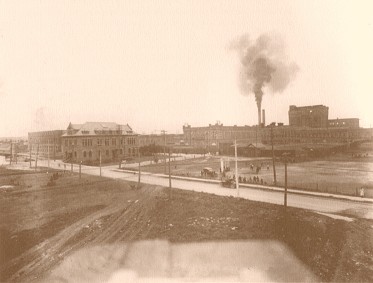
St.Marys Paper
St. Marys Paper occupies the earliest industrially developed site
in Northern Ontario. Although French explorers visited the area as
early as 1622, development did not begin until 1784 when a trading
post was established by the Northwest Company on the site. The post
consisted of the Chief Factor's house, a powder magazine, a barrack
and a number of warehouses. The warehouses stored merchandise destined
for western and northern trading posts and also furs bound for Montreal.
The first canal connecting lakes Superior and Huron was completed
in 1798. A replica of this "bateau lock" is currently located
north of the main office building.
On the south side of the lock, a water-powered sawmill with two saws
was constructed. Government records show that 14 men were employed
directly by the Northwest Company in 1802, in addition to the voyageurs
living in Sault Ste. Marie, who supplied the crews for bateaux and
freight canoes.
During the war of 1812, an armed force of 150 United States soldiers
attacked Sault Ste. Marie, destroying all buildings and structures,
including the locks. Only the stone walls of the magazine remained.
A particularly serious loss was the destruction of the sawmill, the
only one in the entire North West.
Shortly after the attack a temporary post was constructed at the mouth
of the Fort Creek, approximately ¼ mile east of the original
site. The Hudson's Bay Company opened a permanent post in 1842. It
remained in service until 1867.
Sault Ste. Marie Industrial Development
Major industrial development began in Sault Ste. Marie just prior
to 1890. During that period, a group of Philadelphia entrepreneurs,
under the leadership of Francis H. Clergue of Bangor, Maine, became
interested in constructing a hydro electric plant, harnessing the
waterpower available from the St. Marys River.
Shortly there after, Clergue established the Lake Superior Corporation
and began construction of a groundwood pulp mill which became operational
in 1896. The pulp grinders were pocket-type, driven directly through
mortise gears, from vertical water wheels. Pulp produced was dried
on single cylinder steam heated dryers. It was shipped in rolls, by
steamer, directly from the docks below the grinder room.
In 1899, a sulphite mill was constructed. It consisted of two 17ft.
diameter by 54 ft. high, lead lined vertical digesters. They were
in operation until September, 1903, when they were shut down due to
financial difficulties and unfavourable market conditions.
Lake Superior Paper Company
The Lake Superior Paper Company began construction of the area's first
newsprint paper machines in 1911. By the following summer PM1 and
PM2 were commissioned. By the end of 1913, PM3 and PM4 were also operational.
Spanish River Pulp & Paper Mills Ltd.
In 1917, the Lake Superior Paper Company and the Spanish River Pulp
& Paper Mills Ltd. amalgamated. Improvements to the groundwood
pulp mill took place in 1918 and 1926 to meet the increasing demands
of the paper machines.
Abitibi Power & Paper Company
The Abitibi Power and Paper Company assumed ownership of the mill
on August 1st, 1928. In 1929 and 1930, all four paper machines underwent
major improvements. Demand for newsprint kept these machines operating
continuously until World War II when one machine was shut down for
a short period due to lack of pulpwood.
Following the war, capital expenditures continued within the mill,
including the installation of three debarking drums, a new grinder
room, upgraded screening systems, modernized groundwood and sulphite
screening systems, new boiler house equipment and numerous paper machine
upgrades. In addition to newsprint, groundwood specialty papers such
as directory and catalog were now manufactured. Capacity was increased
to 400 tons per day.
In 1947 the Central Research Division of Abitibi was relocated to
the mill site. Many notable contributions to pulp and paper industry
originated from this group.
10/15/1997 became Abitibi-Price Inc
5/29/1997 became Abitibi-Consolidated
St. Marys Paper Inc.
In 1984, a change in ownership and product occurred. Dan Alexander,
an American investor purchased the mill from Abitibi renaming it St.
Marys Paper Inc. Modifications to PM3 and PM4 and the installation
of two Supercalenders made the production of SCB grades possible.
In 1988, the construction of a new paper machine, PM5, was completed,
giving the mill the capacity of producing SCA grades. In addition,
new Tampella grinders were also installed to meet the increased demand
for pulp.
St. Marys Paper Ltd.
In 1994, mill employees and a group of outside investors lead by Ron
Stern, assumed ownership of the mill. An influx of capital led to
improvements in quality and productivity.
This mill enjoyed its "100th" anniversary of operation in
1995, and looks to continuing its development of high value-added
printing grades.
Spring 2010 mill closed.
December 30, 2011 entered receivership. Mill closed.
April 2012 property bought by Riversedge Developments Inc. a brownfield
site developer. Some buidlings demolished.
